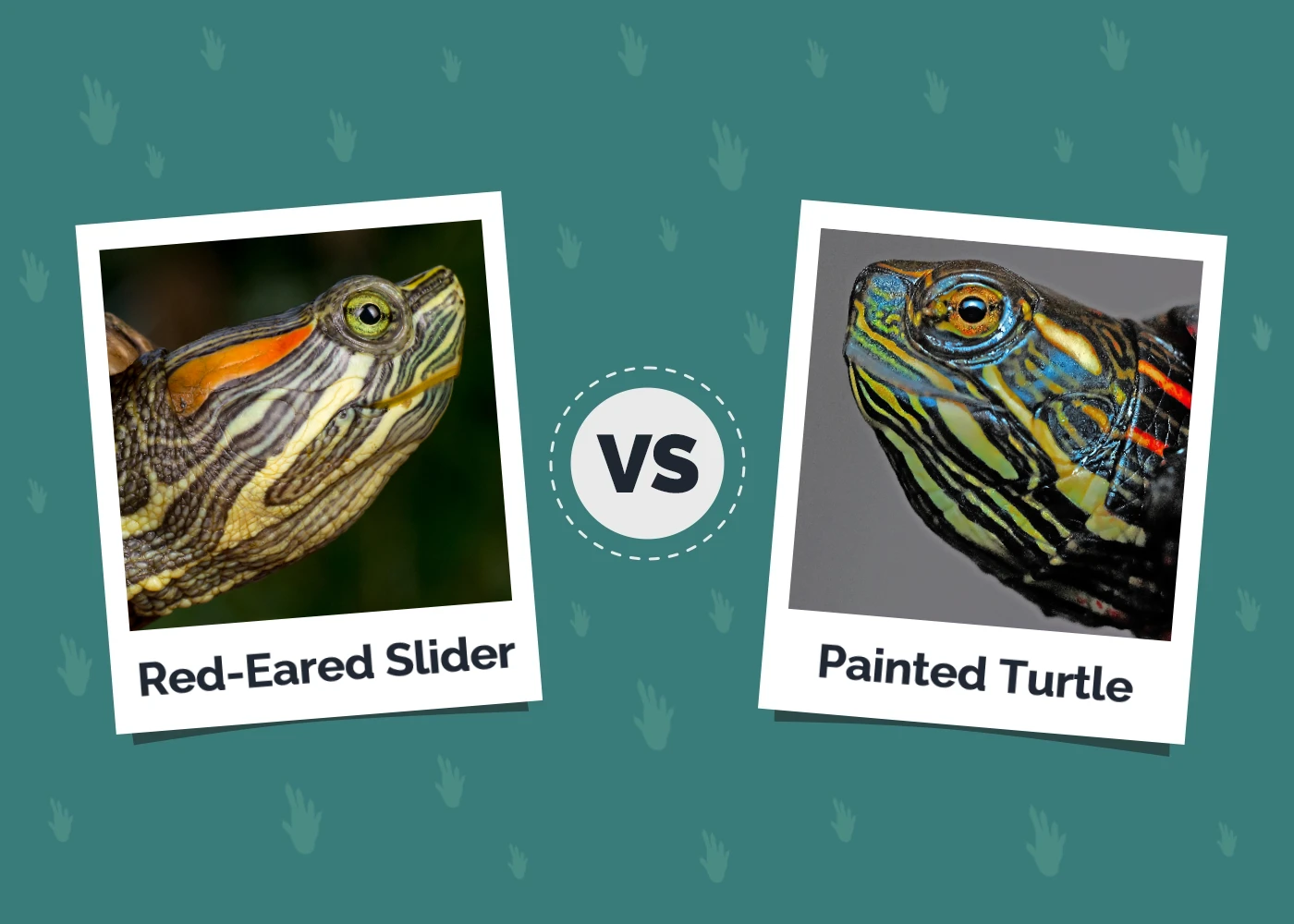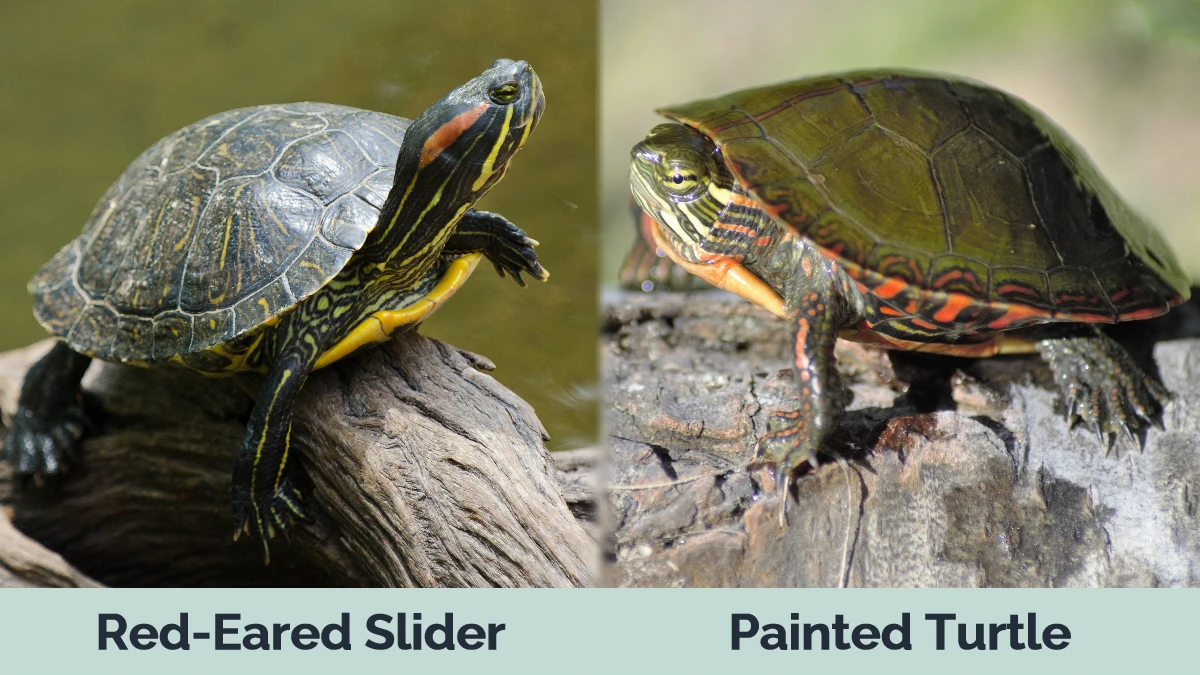Red-Eared Slider vs Painted Turtle: The Differences (With Pictures)

Updated on

Click to Skip Ahead
Exploring the world of reptiles can be an intriguing journey, especially when it comes to understanding the differences and similarities between certain species. Today, we’re focusing on two popular yet distinct breeds – the Red-Eared Slider and the Painted Turtle. Both are captivating in their own right, with unique characteristics that set them apart. Let’s delve into the details!
Visual Differences

At a Glance
- Origin: United States
- Size: 6 to 12 inches
- Lifespan: Up to 30 years
- Domesticated? Yes
- Origin: North America
- Size: 4 to 10 inches
- Lifespan: 20 to 30 years
- Domesticated? Yes
Red-Eared Slider Overview

Characteristics & Appearance
Red-Eared Sliders are known for their hard shells and distinctive red stripe behind each eye. Their shells are typically green with yellow streaks, and their compact bodies are perfect for swimming. These turtles can live up to 30 years, making them a long-term commitment.
Habitats and Care Needs
Red-Eared Sliders prefer warmer climates and are native to the southeastern United States. They are commonly found in ponds, lakes, marshes, and streams. They need access to dry, sunny areas for basking.
Red-Eared Sliders generally require a larger habitat due to their larger size. A sizable aquarium with both water and land areas is necessary. It is recommended that they eat a mix of commercial turtle food, insects, and fresh vegetables. Regular vet check-ups and careful monitoring of their behavior and appetite are essential.
Pros and Cons of Red-Eared Sliders
- Active and Engaging: Red Eared Sliders are known for their active nature, which can be entertaining to watch.
- Long Lifespan: With proper care, these turtles can live up to 30 years.
- Large Housing Requirements: Due to their size, Red Eared Sliders require a sizable habitat, which can be a challenge for some pet owners.
- Specific Diet: They require a varied diet that includes both animal protein and vegetables.
Painted Turtle Overview

Characteristics & Appearance
Painted Turtles are colorful creatures, with dark shells adorned with red and yellow markings. They have slightly webbed feet and smooth, flat shells, ideal for both land and water navigation. Painted Turtles also have a long lifespan of up to 30 years, requiring a significant time commitment.
Habitat and Care Needs
Painted Turtles reside in a variety of freshwater environments, including marshes, ponds, and slow-moving rivers. They are widespread across North America, found from southern Canada to northern Mexico. Like their Red-Eared Slider counterparts, Painted Turtles also require sunny basking spots.
Similar to Red-Eared Sliders, Painted Turtles need a large tank with both land and water areas. A combination of commercial turtle food, fish, and fresh greens should be provided. Routine vet check-ups and vigilance for signs of illness are important.
Pros and Cons of Painted Turtles
- Colorful Appearance: The vibrant colors of Painted Turtles make them visually appealing pets.
- Moderate Size: Being slightly smaller than Red Eared Sliders, they may be easier to accommodate.
- Cooling Requirement: Painted Turtles require a cooling period or hibernation during winter, which can be difficult to manage in a home setting.
- Diverse Diet: Like Red Eared Sliders, Painted Turtles also need a balanced diet of meat and vegetation.
What Are the Differences Between Red-Eared Sliders & Painted Turtles?
While both Red-Eared Sliders and Painted Turtles belong to the turtle family, they differ in their coloration and size. Red-Eared Sliders have the distinctive red ear marking, while Painted Turtles are known for their vibrant shell patterns. In terms of size, Red Eared Sliders are generally slightly larger than Painted Turtles.
Generally, Red-Eared Sliders are known for their active nature, while Painted Turtles are moderately active. Both species can be handled, but it should be done minimally to avoid causing them stress. Always wash your hands before and after handling them to prevent the spread of diseases.
Which Breed Is Right for You?
Choosing between a Red-Eared Slider and a Painted Turtle depends on various factors, such as your personal preferences, living situation, and willingness to take care of a pet. Either one can be a delightful companion if you are willing to provide for their particular care requirements.
Both species are generally harmless. However, always use caution when handling them, as they may scratch or bite if startled or threatened. It is also important to remember that all turtles can carry salmonella, so be sure to wash your hands after handling them.
Poor water quality is one of the most common health concerns for these species. It is important to check and maintain their habitat regularly to keep the water clean and free of debris. While both species require specific care, they can make rewarding pets with the right owner. As long as their dietary and habitat needs are met, these turtles can thrive in captivity.

Conclusion
Red-Eared Sliders and Painted Turtles are two different types of turtles, each with their own unique characteristics. Red-Eared Sliders have a tough shell and a red stripe behind their eyes, while Painted Turtles are known for their vibrant shells. It’s important to provide both breeds with a spacious tank complete with both water and land areas, as well as a well-balanced diet. Ultimately, the decision between a Red-Eared Slider or Painted Turtle as a companion depends on your lifestyle and willingness to provide proper care. Luckily, there’s no bad choice!
Featured Image Credit: Left – Muhammad Naaim, Shutterstock | Right – 631372, PIxabay










